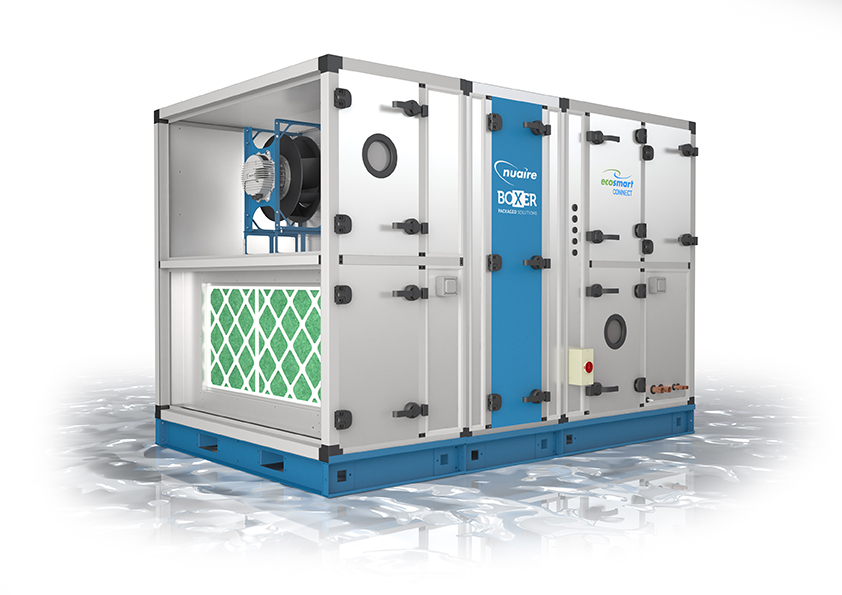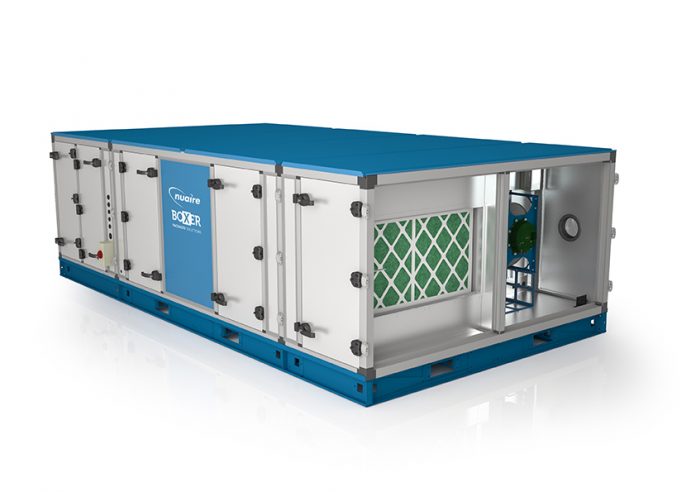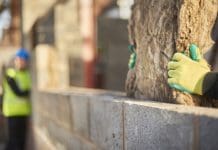Andrew Bott, Technical Sales Manager, Nuaire questions if regulations go far enough to improve the energy performance of Air Handling Units
You may be familiar with the changes to the Energy Related Products Regulations (ERP) that were thrust upon the industry at the start of 2016. These changes raised the bar to demand 67% efficiency from thermal wheels and plate exchangers, rising to 73% in 2018. But does ERP go far enough to improve the energy performance of Air Handling Units (AHU)? And is the recovery efficiency the only metric we should consider when assessing large air handling systems competitively?
It is tempting when considering an AHU to focus primarily on cost, with the other key metrics like energy-efficiency and manufacturing quality being, in many cases, a second thought. It is my belief that, while striving to lower costs and focus specifically on a prescribed recovery efficiency, a number of other key considerations are being sacrificed, in particular, the build quality.
Leakage class
One of the first things to be sacrificed is the ‘leakage class’. The BS EN 1886:2007 standard describes the Leakage Classification as the amount of air able to leak in or out of the unit under positive or negative pressure. It follows that if air is allowed to leak from the unit during normal operating pressures, there is wastage of energy and a reduction in performance when converting electrical energy to kinetic air movement.
A leakage classification of L1 means that under test conditions the unit shall not leak more than 0.22 l/s per m2 of outer face area in the positive pressure section, and 0.15 l/s per m2 of outer face area in the negative pressure section. Many of the air handling units I see on the market today are only able to achieve a leakage classification of L3, which equates to an air leakage of almost three times the L1 benchmark. This might seem a small difference but the effect on build quality is astonishing, and the amount of energy wastage due to a poorly performing enclosure is often not considered.
When you couple the leakage classification with the inevitable effect poor build quality has on the mechanical strength of the AHU (Defection Class), the results can be startling. A defection Class of D1 permits a casing deflection of just 4mm per metre, while the D3 classification allows for AHU casing to be deflected by up to 10mm per metre. AHUs with a poor deflection classification are more likely to leak air out and can allow water to leak in, which ultimately lowers the lifespan of the unit and causes premature malfunction.

Thermal bridging
One of the most surprising oversights I find when it comes to the selection of AHUs is the consideration given to the ‘thermal bridging’ of the AHU framework. The BS EN 1886:2007 standard defines thermal bridging as the separation of the conductive metallic internal and external surfaces, with an insulating material. Nuaire has incorporated an integral thermal bridge into the framework construction of its Boxer Package Solution (BPS) air handling units to achieve the maximum possible thermal bridging classification of TB1.
This reduces the amount of heat energy lost to the outside atmosphere by creating an isolation between the internal frame and the external surfaces. When this thermal break is combined with a Thermal Transmittance rating of T2, the thermal performance of the overall AHU is greatly improved. This reduces the formation of condensation on the unit surfaces and traps the heat energy into the air flow, preventing it from escaping to the atmosphere.
Do regulations go far enough?
When one considers the competitive AHU market as a whole, the continued struggle to lower cost is often achieved by sacrificing on the build quality and the focus is placed specifically on achieving the bare minimum of compliance for specific fan power and recovery efficiency.
So the question is; “Does ERP go far enough to define the acceptable standards for AHU performance?”
I would expand on this question further by asking; “Do we spend enough time considering the project life cycle when we are selecting products for the built environment?”
Personally, I feel the answer to both questions is no.
Over the lifetime of a project, the inherent cost is initially affected by the energy performance and running costs. But when the longer term is considered, the failure rate and inherent lifespan of equipment play a bigger part in the equation. I would like to see the regulations that drive energy performance also require a significant improvement in build quality, or we risk any improvements made in the short-term carbon footprint being wasted or overturned by early equipment replacement.
Finding a balance between short-term energy gains and long-term equipment performance is the key to reducing and protecting the improved carbon footprint we all strive toward.
Cost-effective Air Handling Units
Nuaire has developed Boxer Packaged Solutions (BPS), a range of pre-selected, packaged air handling units that offer a cost-effective solution to this issue.
BPS offers L1 Leakage Class, D1 Deflection Class, TB1 Thermal Bridging and T2 Thermal Transmittance, while comfortably achieving the base standards set out in ERP 2016/18 for recovery efficiency and Specific Fan Power. So I would like to pose the question; “Is it time to ask for better Air Handling Units?” Not because we need to, and not because the regulations tell us to, but because we should do.
We should ask for better, we should challenge the status quo, and we should consider the built environment we deliver to the end user. The buildings we hand over, in the end, will need to be maintained and enjoyed by their occupants for many years into the future and demanding better will ensure that the maintenance costs and energy improvements we design today will last far beyond the defects period.
Nuaire
Tel: 029 2085 8500
info@nuaire.co.uk
Please note: this is a commercial profile














